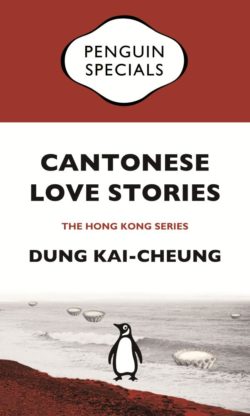Cantonese Love Stories by Dung Kai-cheung
translated by Bonnie S. McDougall and Anders Hansson
2017, Penguin Specials
Publisher's blurb
A collection of twenty-five narrative sketches, Cantonese Love Stories offers an intimate look into the cultural, commercial and romantic milieu of Hong Kong in the 1990s. Two lovers ruminate on the power of their photo booth stickers to keep them together. Peach-pocket Girl reads stolen love letters at a café. Pui Pui knows a Portuguese egg tart is authentic if she dreams of riding a boat-like egg tart. Each character inhabits a different corner of Hong Kong's dreamscape; together they bring to life Dung Kai-cheung's imaginative vision of the city.
Reading Chinese Network Reviews
Reviewed by Paul Woods, 5/10/18
 This slim volume contains two dozen short stories set at the time of Hong Kong’s return to China at the end of the last century. In the introduction we learn that the author sees these vignettes as sketches rather than stories. I agree. First of all, they are very short indeed, some only four pages long. Even as skilled a writer as Dung Kai-Cheung would struggle to squeeze a complete narrative into so short a space. Secondly, they are sketches in that they give an outline or general portrait only; the reader has to supply a conclusion. Indeed, one of the most satisfying or annoying features of the collection, depending on your experience and personality, is that the end of the text is not the end of the story. We are almost compelled to wonder why the events happened as they did and what happens next. Finally, the paucity of plot advancing information and the brevity of the stories combine to make the reader feel like a passenger in one train looking at those in another as they move along on parallel tracks. Usually trains are next to each other and moving at the same speed for a short time; we can see into the other train and glean basic information and even some details about those inside it, but we still do not know much about them or where they are going and why. Dung’s sketches contain details, but the genius is that there is not enough to carry off a complete story. At best, we can only come alongside for a while.
This slim volume contains two dozen short stories set at the time of Hong Kong’s return to China at the end of the last century. In the introduction we learn that the author sees these vignettes as sketches rather than stories. I agree. First of all, they are very short indeed, some only four pages long. Even as skilled a writer as Dung Kai-Cheung would struggle to squeeze a complete narrative into so short a space. Secondly, they are sketches in that they give an outline or general portrait only; the reader has to supply a conclusion. Indeed, one of the most satisfying or annoying features of the collection, depending on your experience and personality, is that the end of the text is not the end of the story. We are almost compelled to wonder why the events happened as they did and what happens next. Finally, the paucity of plot advancing information and the brevity of the stories combine to make the reader feel like a passenger in one train looking at those in another as they move along on parallel tracks. Usually trains are next to each other and moving at the same speed for a short time; we can see into the other train and glean basic information and even some details about those inside it, but we still do not know much about them or where they are going and why. Dung’s sketches contain details, but the genius is that there is not enough to carry off a complete story. At best, we can only come alongside for a while.
Cantonese Love Stories reminds me of Singapore writer Alfian Sa’at’s Corridor – another collection of short stories, each of which has plenty of detail but a frustrating lack of closure. While Alfian’s work is realist in that the stories ‘could have happened’, Dung is a little more speculative. For me, there are resonances with a short story collection set in another Asian metropolis, Prabda Yoon’s Bangkok-focused The Sad Part Was. Another similarity between Cantonese Love Stories and Corridor is the use of rather opaque noun phrases as motifs and names for the stories. Dung’s combination of everyday objects and brand names in handover-era Hong Kong, such as Hello Kitty, Red Wing shoes, aprons, Adidas, and the duffel coat, connects with the lives and aspirations of ordinary people.
Three stories hint at the mind-games Dung plays with his readers. In Agnes b (name of a fashion brand) a man becomes interested in a young woman he has only seen from behind while waiting for an MTR train. He fantasises about tracing the vertebrae in her beautiful neck and later she tells him that he examined her spine four years ago because she has congenital curvature. However, the young man is an accountant and not a doctor. In Hello Kitty a woman applies too much lipstick and then removes it in anger. At home, she adds lipstick to the large number of Hello Kitties in her house. In a nightmare she wipes off her lipstick and her mouth, and on waking finds that the Hello Kitties now also lack mouths. Finally, in Windows 98 two female friends find themselves with new boyfriends, both skilled with computers. In one case, Windows is installed and the computer boots up, and the relationship seems to be moving forward. In the other, the boyfriend comes to his girlfriend’s house and there is a brief sexual encounter, after which he leaves without a word. They forgot to install Windows and when the girl attempts to do the installation herself, she fails repeatedly. The installation and running of Windows 98 is some kind of metaphor for relationships. In all three stories, there is some violation of cause and effect and temporality. What is reality and what is imagination? Are we the masters of our own fates? Do we control objects or do they control us? I am reminded of Dung’s mention of Zhuangzi in the introduction to the collection and the Daoist master’s story blurring the distinction between man and butterfly.
Dung seems to be critiquing materialism and manipulative relationships. There is a yearning here for the simple and the pure, unadulterated by commercialism and the interference of outsiders in interpersonal relationships. He focuses closely on the daily and thought lives of ordinary people against the background of a complex and fast-moving global city. Yet there is more here; Love Stories feels like a counter-narrative but it is not completely clear what Dung is reacting against.
The sketches feel rooted in a Hong Kong which has a strong sense of its own identity; its Chineseness is somehow tempered or restrained. Dung’s Hong Kong remains more recognisable than the anonymous setting of Hon’s The Kite Family, for example. As someone who has spent quite a lot of time in the territory, I found it easy to enter into the stories, even if parts of them felt odd and non-logical. Cantonese Love Stories grows on you as you read, re-read, and think about it.
The translation was very well done and read very smoothly. That said, I would love to see the original Chinese text and see how Cantonese the writing was. The introduction is very helpful and a table of contents would have been nice.
Reviewed by Paul Woods
Reviewed by Stephanie Boote, 2/7/18
 A collection of Dung Kai-Cheung’s short stories selectively chosen to illustrate a less than flattering perspective of Hong Kong, this quick read left a lasting impression on me. The overt themes of consumerism and iconography in each of these stories outline the personalities and destinies of the characters whilst an indifferent narrator recounts their tales of woe to the reader. The selection of stories all focus around the influence of brand name products, iconic figures or distinctive possessions, intentionally establishing a city in which people’s relationships are intensely impersonal. On finishing reading this collection I felt unsettled due to the lack of resolve in the stories, the purpose of which seems to be only to impart a deep sense of loneliness.
A collection of Dung Kai-Cheung’s short stories selectively chosen to illustrate a less than flattering perspective of Hong Kong, this quick read left a lasting impression on me. The overt themes of consumerism and iconography in each of these stories outline the personalities and destinies of the characters whilst an indifferent narrator recounts their tales of woe to the reader. The selection of stories all focus around the influence of brand name products, iconic figures or distinctive possessions, intentionally establishing a city in which people’s relationships are intensely impersonal. On finishing reading this collection I felt unsettled due to the lack of resolve in the stories, the purpose of which seems to be only to impart a deep sense of loneliness.
Due to the indifferent tone of the narrator’s voice in these stories I don’t feel that Dung Kai-Cheung was highly critical of consumerism in Hong Kong, instead he was using these products in order to emphasise the isolation between these characters. To me this is an extremely clever narrative device as the brands used are for the most part universally known. This increases both their appeal and their ultimate meaninglessness. A Prada briefcase for example, is immediately recognisable as something expensive and important throughout an international market. A product which would be likely to influence your first impression of someone. However, in Suki’s story the nature of its notoriety decreases its personal connection with her, as everyone recognises it and it ends up overshadowing her entirely. Undoubtedly, the story was never about Suki loving her Prada briefcase, instead the briefcase symbolises her difficulty in finding solid human connection and in the end it doesn’t even matter if it was even real or fake.
This is significant as the products around which the stories fixate are all just symbols. Their influence on the stories are purely superficial, hinting at backdrops and emotions without actually influencing the ways that the stories play out. A striking aspect of these stories is that despite highly traumatic events taking place the narrative style is extremely impersonal, to the extent that sometimes disturbing scenes, such as Ah Chi’s sexual assault in Che, almost slipped entirely past me. It is clear that in each of these stories, each character is going through an emotionally turbulent period in their lives, but at all times the narrative voice remains indifferent. Reading these stories feels just like people watching from behind a window, taking impressions from people’s distinctive possessions without ever approaching them.
Which honestly may be a factor in why I am not fond of the use of translators' notes throughout the collection. On the one hand, the context of the products is instrumental to each of the stories, if a reader didn’t know what Air Jordans were, it would be a detriment forming an understanding of Mei Sui’s emotional state. Thus a quick explanation of the product is helpful. However, I found these introductions at best unnecessary and at worst disruptive to the flow of the stories. Of course the job of translating a work of fiction is highly challenging and honestly I feel that a much longer discussion of a translator’s influence would be needed here. Nonetheless, I struggled with the fact that these introductions were added as they contrasted the narrative tone of the stories. The narrator at no point provides a sense that they are concerned with the reader, simply imparting the stories as they occur. The introductions on the other hand seemed to be asides, the translator explaining to the reader a detail which, more than once, is actually illustrated in the story itself. For me this was most explicit in the story Non-no in which the translator explains the context of types of specific teenage magazines – only to then immediately and sufficiently outline the nature of these magazines in the very first paragraph of the story itself. I feel that the reader could have been given more credit in this instance, as, especially in 2017 with Google so accessible, if there had been any confusion it would not have been hard to clear up any misconceptions.
A further issue I had with this is that it undermines an underlying theme of stories that ultimately the products themselves are not crucial to the story, instead it is the meaning given to them by the characters and the reader. Thus it’s not really necessary that the reader know that Air Jordans, for example, were “released for public consumption in 1985” as that isn’t really what’s important here. In fairness, this theme is for the most part upheld in the stories which do not use a translators' note and instead assume that the reader will understand the contextual importance of the item.
I do however agree that where names make up puns in Cantonese this does not translate into English very gracefully, so I agree that including an explanation of these was relevant and helpful. I just wish that these puns had perhaps been collected in a section at the end or beginning of the book separate from the stories themselves where they wouldn’t have been as disruptive.
Although the stories did leave me staring at the wall for a while feeling pretty pessimistic about the state of the world and the reality of loneliness in a big city, I found this book to be thought provoking and interesting.
Reviewed by Stephanie Boote
Reviewed by Hsiu-chih Sheu, 31/5/18
 Hong Kong with its unique historical background has long been a hybrid of Chinese and western cultures. In this little book, Cantonese Love Stories, Dung-Kai-Cheung uses 25 short stories or “sketches” to depict the voice and mood of this peculiar linguistic community in the 1990s. The love stories use a variety of imported commodities as titles to tell a series of stories about love, relationship, and self-identity. Imported commodities such as Agnes B. bags, Hello Kitty, Pasteis de Nata, Non-no (A Japanese magazines), Air Jordan trainers, Prada, Adidas, Gucci, Burberry, Birkenstock, each carries its symbolic meaning in the life of these protagonists and help to define who they are.
Hong Kong with its unique historical background has long been a hybrid of Chinese and western cultures. In this little book, Cantonese Love Stories, Dung-Kai-Cheung uses 25 short stories or “sketches” to depict the voice and mood of this peculiar linguistic community in the 1990s. The love stories use a variety of imported commodities as titles to tell a series of stories about love, relationship, and self-identity. Imported commodities such as Agnes B. bags, Hello Kitty, Pasteis de Nata, Non-no (A Japanese magazines), Air Jordan trainers, Prada, Adidas, Gucci, Burberry, Birkenstock, each carries its symbolic meaning in the life of these protagonists and help to define who they are.
Some stories are surrealistic and thought-provoking. For example, in “Hello Kitty”, we see a girl, Tsui Kit Yuk, whose mother gives her the English name “Kitty” for her first day of school. Because of the popularity of the Japanese doll, “Hello Kitty”, she gets stuck with the name. Although not particularly fond of the doll, people are constantly showering her with Hello Kitty gifts. When she breaks up with her boyfriend, that evening, she dreams about putting lipsticks on all of her 126 Hello Kitty. As she put lipstick on herself, she finds that the more lipstick she put on, the messier it becomes. She wakes up to find all her Hello Kitties are missing their mouths. Is Kitty, the girl, missing her mouth like Hello Kitty, the dolls?
“Prada” tells the story a young office lady who goes to buy a Prada briefcase after breaking up with her boy friend. First her friends and family think it is a “fake” Prada. Upon realizing it is genuine one, they either show their disapproval, or question her unwise shopping of the real thing that looks exactly like a fake one. At the end of the story, when a new male friend expressed admiration on her Prada bag, she burst out: “It’s just a fake. I got it in Shengzhen for under 200 dollars.” These imported products have brought fashion to the society, but ironically, fashion does not always encourage individuality, instead, it can fortify collective thinking. There are several layers of symbolic meaning deriving from a Prada bag.
A snap shot of Hong Kong culture in the 1990s may look a bit outdated in the 21st Century, but the fashion culture around the world has not lost its grip on the wider social context. In these short sketches, readers can wonder around these interesting scenarios to explore the symbolic meaning of these commodities in a unique society. The translation flows very well. Readers are taken on a walk in the city of Hong Kong with a good social commentary on the city and its people. Some stories are prefaced with a brief introduction.
Reviewed by Hsiu-chih Sheu
Reviewed by Henry Yunwei Wang, 27/5/18
 Darting around Hong Kong just after handover, the little collection of sketches Cantonese Love Stories by Dung Kai-Cheung—part of the Penguin Hong Kong series -- represents an invisible division between reality and fantasy. There are 25 brief vignettes in English translation, excerpted from a larger edition of original with about a hundred. The narratives, lovely and eerie at the same time, clock in at about one thousand words each; the context, revolving specifically the cultural, commercial and romantic milieu of Hong Kong in the late 1990s.
Darting around Hong Kong just after handover, the little collection of sketches Cantonese Love Stories by Dung Kai-Cheung—part of the Penguin Hong Kong series -- represents an invisible division between reality and fantasy. There are 25 brief vignettes in English translation, excerpted from a larger edition of original with about a hundred. The narratives, lovely and eerie at the same time, clock in at about one thousand words each; the context, revolving specifically the cultural, commercial and romantic milieu of Hong Kong in the late 1990s.
Throughout the sketches, various allusions and references sprinkled around Hong Kong are able to be unpacked. In terms of literary genre, they seem to fit squarely into Chinese classical notebook fiction (笔记小说), which features anything the author deems worth recording: anecdotes, quotations, random musings, philological speculations, literary criticism, etc; Almost without exception, each of those snappy stories, has at least a plot unresolved or a narrative arc, a dénouement remaining with high brevity. As for literary tradition, from the Chinese book title Menghualu (梦华录, Catalog) and the author's introduction, we learn that this flash fiction follows and adapts the style of a Song Dynasty memoir, Dongjing Menghualu (东京梦华录), written by Meng Yuanlao (孟元老1090-1150). When the thriving capital of the Northern Song Dynasty was conquered by Jurchen Jin invaders, Meng's book serves a detailed and nostalgic description of the old capital's urban life, covering affluent perspectives of seasonal products, festivals, local cuisines, customs and cultural traditions. Perhaps this is also what Dung was eager to achieve.
When Dung later abandoned the free-style writing of flash vignettes, also in order to better persuade Penguin's editor, Dung finally renamed this work Cantonese Love Stories, linking to a larger picture (according to the author himself) of Hong Kong's colonial history. Implicitly, but more interestingly, Cantonese Love Stories is a homage to Cantonese Love Songs, transcribed by former Hong Kong governor Cecil Clementi over a century ago. Closely intertwined in the Cantonese dialect canon, the poetic resonance of both love stories and love songs are derived from heartbroken disconnection, lovelorn unhappiness, love lost regret; Love that doesn’t come to pass, love that could have been but never was, and love that briefly rears its head only to die moments later. In brief, love is always the biggest illusion.
In ancient Chinese tradition, many objects take on metaphorical roles of symbolising love and affection. In Dung's sketches, each fleeting image of a lost period in time is centred around an object—modern, consumerist existence. Objects and the symbols they present, serve as the root of the wedge of character attachment. Further, divergences in fantasy are all concepts that can be extended to an atomised mirage of the post-modernity of Hong Kong. Konjac Jellies, Lord Snow’s egg tarts, Depsea Water, Burberry's Blue Label, Birkenstock...the fiction finds itself woven into the narratives in peculiar ways with imported goods and brands, pop culture and geographical references. The city, Hong Kong, is also such a patchwork of karma, a common and uniting thread that ties people's lives, stories and histories together, though, those themes are now— escaping, disappearing or dying—running through and out of the book. Another feature of the reading experience lies in the strangeness behind each portrayal. While verisimilitude and transparency are not necessarily Dung’s intention, considerably surreal and opaque jumps may provide a very challenging opportunity for readers to pull back the linguistic veil, even for long-term Hong Kong residents.
Reviewed by Henry Yunwei Wang
Reviewed by Bonnie Cheung, 14/5/18
 Reading this almost pocket-sized book of short stories was a trip down memory lane for me.
Reading this almost pocket-sized book of short stories was a trip down memory lane for me.
I was born in Hong Kong in the early 90’s. I spent the first 8 years of my life there and, though I was young at the time, I could relate to most of the stories within this book in some way. On the whole, what struck me most was the sense of value placed upon an object. Each short story incorporated an object or type of food that came to Hong Kong in the 90’s. Some of the romance stories within this book revolved around an object and, in the case of Windows ’97, a piece of software update.
Among the short stories contained in this short work were several that truly elicited an emotional response.
The first was "Hello Kitty". For me this story really strummed a personal chord. I avidly adored the Hello Kitty brand as a child and always eagerly awaited any new and exciting piece of merchandise. I used to save up as much of my pocket money as my snack-loving-child-self would allow and spend it all on Happy Meals just to get Hello Kitty figurines or other forms of merchandise that ranged from small coin purses to limited edition bracelet charms. My whole family participated in the Sanrio phenomena. We each had a one particular character that seemed to define us as that was the one we liked most. Though my adoration for pink diminished drastically over the years, even now when I see a new Hello Kitty merchandise my inner-child would still squeal in delight.
Another favourite was the story of the Portuguese tarts, pastéis de nata as they are referred to in the book. I used to call them Po-tarts and depending on the company I’m with I still do. It was the name I first learned of them. I’d always known about the egg tarts that were made with a slight crumbly biscuit-like tart. I’d grown up eating them and usually had at least one every other day after school back when I lived in Hong Kong. But I hadn’t actually heard of Portuguese tarts until I went to Macau for the first time. The bizarre and almost compulsive love for these tarts the protagonist had for them also all too relatable. I probably couldn’t count on one hand the number of times I had dreamt of living in a castle made of egg tarts as a child. What I also found fascinating about this story was the cultural references to a Portuguese novelist at the end. It slipped in so naturally and not felt not at all out of place.
The third story that also stuck with me all too easily was "Photo Stickers". I still remember the arrival of sticker booths and the obsession with them. Having a photo sticker of your best-friends, your boyfriend, your favourite person was almost more important than the relationship that actually tied you together. The photo was symbolic. That so long as your friend had your sticker on her phone or pencil case or notebook, your friendship was safe. But as soon as it wasn’t there, it was like the end of the world. I still remember the incomprehensible drama that unfurled when I refused to take one and my friends kicked up such a fuss saying that I was disloyal or didn’t actually like them. The heavy weight of those little stickers that were about the size of a stamp was terrifying. Even now, whenever I think about it I still shudder a little at how much trouble those tiny rectangles could cause.
The language in this book and the extreme shortness of these stories were perfect as I could easily start-and-stop during my lunch break at work without much trouble. Despite their length, each story was succinct and told a much bigger story than the couple of pages might suggest. They were short stories that tore open the flood gates and ushered me down the sweet and sometimes not so sweet path of memory lane.
Reviewed by Bonnie Cheung
Reviewed by Cat Hanson, 5/5/18
 As soon as you step off the ferry in Hong Kong, you're gently buffeted along with the clamour of tourists, occasionally enduring the odd bump on the ankle from a wheel-along suitcase. Once through customs, the crowds spill out into a glittering, golden shopping mall, where air-conditioned doorways beckon you to come inside and take a look, and mirrored walls and floors prevent an easy escape anyhow. Labels, bags, creams, shadows - it's all here and waiting for your custom. But what's driving the consumerism? What are the identities at play behind the bargains?
As soon as you step off the ferry in Hong Kong, you're gently buffeted along with the clamour of tourists, occasionally enduring the odd bump on the ankle from a wheel-along suitcase. Once through customs, the crowds spill out into a glittering, golden shopping mall, where air-conditioned doorways beckon you to come inside and take a look, and mirrored walls and floors prevent an easy escape anyhow. Labels, bags, creams, shadows - it's all here and waiting for your custom. But what's driving the consumerism? What are the identities at play behind the bargains?
It's why I was so interested in Dung Kai-Cheung 's take throughout Cantonese Love Stories. Snapshots of people's lives often told through the lens of a designer coat, or a new pair of shoes, or even an old movie. Hong Kong was and remains a thriving hub for shopping, international commerce and luxury. However, what we see on the surface can't possibly symbolise the rich tapestry of experiences, relationships and histories behind the city's inhabitants.
Another aspect to Dung's framing is hinted to in Virginia Anderson's introduction. Dung considers his 'vignettes' to be sketches rather than short stories. Sketches on television seldom waste time with introductions, descriptions, and the like. So how do directors and comedians set the scene? With props, objects and eye-catching clothing. We often use this visual aid to make assumptions on the characters. Perhaps they're rich, vulgar, busy, lazy, old or young. Maybe is trying to turn this on its head in through the written word. Can items really tell us the whole story? Let's take Kit Yuk for example, who loathes her collection of Hello Kitty, but would never say so. Or the sturdy Air Jordan's gifted to Mei Sui by her boyfriend Tun Wing, that really become a symbol of the couple's fragile relationship. The characters don't hide behind their materials items. Rather, they challenge our own perception of what it means to own, buy, or gift something.
A common theme that stood out to me was the destruction of the items and the subsequent destruction of a myth, false appearance, or fantasy. When Dipsi's romantic love affair falls apart, she empties her collection of Depsea Water - the item tying her to her lover. Or Ah Pan's relinquishing of his beloved cowboy hat, which in turn disappoints Happy as a reminder of her unrequited love (or just interest?) with Ah Pan. Again, there's a sense of material items being a mask, or a quick-fix, but never really patching up the true hurt or pain. It's amazing that Dung manages to capture this in the space of a few pages - more so than many novels or epic feature-length films.
I'll confess - I was often confused by the stories, searching for a punchline or a moral or some deeper meaning. But perhaps I was trying too hard. It's not always the writer's intention to teach us something. Why not just enjoy the complex backstories that are around us - why shouldn't we document a snapshot of the times, or possess material goods, without it having to prove something?"
Reviewed by Cat Hanson
Reviewed by Markéta Glanzová, 30/4/18
 Cantonese Love Stories is a tiny book of 25 stories written by Hong Kong writer Dung Kai-Cheung. The stories in this book were selected from The Catalogue which was written between 1998 and 1999 and contained ninety-nine stories. Almost twenty years later Dung Kai-Cheung himself selected twenty-five stories and made a collection out of them, which he named Cantonese Love Stories. The author doesn’t like to describe the pieces as “short-stories” but he prefers to refer to them as “sketches” instead, which is quite fitting description for Cantonese Love Stories which depict the “slices of life cut out from reality, fresh and raw” (11).
Cantonese Love Stories is a tiny book of 25 stories written by Hong Kong writer Dung Kai-Cheung. The stories in this book were selected from The Catalogue which was written between 1998 and 1999 and contained ninety-nine stories. Almost twenty years later Dung Kai-Cheung himself selected twenty-five stories and made a collection out of them, which he named Cantonese Love Stories. The author doesn’t like to describe the pieces as “short-stories” but he prefers to refer to them as “sketches” instead, which is quite fitting description for Cantonese Love Stories which depict the “slices of life cut out from reality, fresh and raw” (11).
Most of the sketches deals in some way with commercial brands (like Hello Kitty, Prada, Gucci…) which were famous in 1990´s Hong Kong. Characters sometimes seem to be obsessed with possessing them. An example can be a girl from a Prada store who spends three thousand dollars on a Prada handbag. However, later she found out that not only has she to justify buying the handbag to herself, but moreover, none of her friends and relatives believes that the handbag is not a fake. Later she starts pretending that it really is a fake, and her problem is solved. However, the brands in the stories usually have some deeper meaning to express. In a story called "Hello Kitty" the main character didn’t even choose herself that she would like the Hello Kitty brand, but her mum and friends started calling her Kitty (because she reminded them of a cat) and from that moment everyone kept buying her products with Hello Kitty for every occasion. Kitty didn´t oppose this, just learnt to live with it. The story "Hello Kitty" provides us with an unbelievable list of Hello Kitty products like “toasters, radios, TVs, cameras, mobile phones, vacuum cleaners, electric fans, credit cards, cotton padded quilts, household furniture, notebook computers, cars and hundreds of other things. There were also teddy bears, chickens, puppies and cats, cats and more cats, all dressed up as Hello Kitty” (23), which shows us the expansion of the brand which sometimes maybe even verges on obsession or insanity But the Hello Kitty in this story is not simply a brand but is also used as a label, which was given to the girl and which she can´t get rid of and she is forced to dissimilate her whole life. Even though the reader could think that as the Cantonese Love Stories focus on describing life in a high-capitalist and commercialized society of Hong Kong, they would be realistic, but the opposite is true and even the story of Hello Kitty turns quite fantastic in the end.
If the sketches should be described just in one word, it would be the word dreamy. Sometimes it is hard to say where the reality ends and the dream starts. Sometimes what starts as an ordinary day turns into something extraordinary and fantastic. The meaning of the stories is not a fixed one but multiple. It seems to me that it was author´s intention to give stories multiple meaning, as he wanted to make the readers to create their own conclusions and meanings. What is so special about this tiny book is, that different stories will resonate with different people, so there can never be a consensus, and probably even the same story will be understood differently by different readers.
As well as showing us life in 1990´s capitalist Hong Kong, Cantonese Love Stories have spiritual depth, which will hit every reader differently and definitely won´t let anyone remain indifferent. Some stories you will love, some you will dislike, some you won´t understand at all, but there will definitely be a story which will touch you and which will not let you go.
Reviewed by Markéta Glanzová
Reviewed by Barry Howard, 29/4/18
 If you want to read literature but have little time to spare then this collection of 25 stories set in 1990s Hong Kong would seem ideal. A brief translators’ note is helpful and gives some context. That is followed by a researcher of Hong Kong literature adding some background as to how Dung came to write these stories. Again, useful and probably necessary given the choice of tales. As an aside, I was puzzled by a reference to her memory of Prince Charles and Chris Patten “catching their last…glimpse of the city that their forbears had founded, and which they had lost.” That’s a very loose comment considering how Britain actually came to possess Hong Kong.
If you want to read literature but have little time to spare then this collection of 25 stories set in 1990s Hong Kong would seem ideal. A brief translators’ note is helpful and gives some context. That is followed by a researcher of Hong Kong literature adding some background as to how Dung came to write these stories. Again, useful and probably necessary given the choice of tales. As an aside, I was puzzled by a reference to her memory of Prince Charles and Chris Patten “catching their last…glimpse of the city that their forbears had founded, and which they had lost.” That’s a very loose comment considering how Britain actually came to possess Hong Kong.
As for the tales they really are very short and there’s a feeling that their brevity is too much for a translation. When you have a translator having to start many of them with explanations, you have to wonder about how this collection came about. I cannot see how a niche market, such as translated Chinese literature, benefits from taking such a difficult path.
This should be the point when I suggest a list of hits and misses. Like a comedy sketch show it’s rare that every part appeals, but something should. And maybe it would have if I was able to read the original. The translators mention ‘the author’s fondness for puns and wordplay’, yet I cannot get that from the translation. It’s lost.
“Cantonese Love Stories offers an intimate look into the cultural, commercial and romantic milieu of Hong Kong in the 1990s.” Having lived there for part of that decade, I recognise the references to Japan (Hello Kitty), technology (Windows 98), basketball (Air Jordan), fashion (Gucci, Prada, Burberrys Blue Label), insect life (The Cockroach) and food (Pastéis de Nata). Yet what of the major event of this period?
There’s no sense of a city and its people profoundly affected by the 1997 handover. That’s possibly because Dung tackled that in Atlas: The Archaeology of an Imaginary City – the initial volume of his V-City series of which The Catalog is a later volume (from which Cantonese Love Stories are taken).
The book is promoted as part of The Hong Kong Series – “Twenty-five vignettes of a city”. Yet just like the brand names, many of these stories could be found all over the world. The result is bits of Hong Kong, without seeing or comprehending any of the whole.
Reviewed by Barry Howard
Reviewed by Zahra Raja, 29/4/18
 I came to the conclusion after reading this collection of short stories that anyone without a Hong Kong background or an insight into life there in the 90s would struggle to wholly understand the vignettes, and my suspicions were confirmed when my friend who was born in Hong Kong and spent her formative years there explained her interpretation of the stories. This problem was likely anticipated and explanations are inserted before certain stories in order to give some context, however I did not find them particularly helpful; it is rather comparable to why you wouldn’t find a joke funny if you had to have the punchline explained to you. As such this collection will likely be enjoyed most by those with such insight; however that is not to say they have no value to the casual reader with no knowledge of Hong Kong; there were several stories that I really enjoyed and gleaned meaning from.
I came to the conclusion after reading this collection of short stories that anyone without a Hong Kong background or an insight into life there in the 90s would struggle to wholly understand the vignettes, and my suspicions were confirmed when my friend who was born in Hong Kong and spent her formative years there explained her interpretation of the stories. This problem was likely anticipated and explanations are inserted before certain stories in order to give some context, however I did not find them particularly helpful; it is rather comparable to why you wouldn’t find a joke funny if you had to have the punchline explained to you. As such this collection will likely be enjoyed most by those with such insight; however that is not to say they have no value to the casual reader with no knowledge of Hong Kong; there were several stories that I really enjoyed and gleaned meaning from.
One of the stories I liked most is the chapter ‘Hello Kitty’; Tsui Kit Yuk begins to be associated with liking Hello Kitty products from her childhood, and any present she received would inevitably be related to Hello Kitty. Despite Kit Yuk’s indifference towards the brand, she is too polite to say otherwise and resigns herself to her fate of only receiving Hello Kitty related gifts. After breaking up with her boyfriend, and receiving more Hello Kitty gifts from well-meaning friends, she puts lipstick on all of 126 Hello Kitty dolls that she owns, and in her dreams when she tries to wipe off her own, she wipes off her own mouth. When she wakes, all the dolls are missing mouths. These Hello Kitty gifts have come to define Kit Yuk’s own identity; as she is unwilling to speak out against them, she is trapped in an identity not of her own constructing, and this manifest itself in her nightmares. One of the reasons I liked this story so much is that it shows the consequences of attaching labels, which is very much a human experience.
Cantonese Love Stories is an interesting read, but without the requisite background knowledge the collection will inevitably be devoid of the meaning that the author intended it to have. Any story that needs a paragraph long header explaining the context was probably originally intended for a certain audience. They are worth reading, as long as the reader accepts the caveat that they won’t understand half of it and enjoys the stories in all their weird and wacky glory; failing that they can find someone who was around at the time to explain it all, but where would be the fun in that?
Reviewed by Zahra Raja
Reviewed by Andreea Chirita, 26/4/18
 Cantonese Love Stories is a collection of twenty-five literary "pills" filled with a strange sense of nostalgia for a Hong Kong frozen in time during the nineties. Or at least that’s the perception of a new millennium reader, ready to explore, farther than its overwhelming skyscrapers, into the city’s trivial but exhilarant splendor. Writer and playwright Dung Kai-cheung was born and raised in Hong Kong, and that shows in every single line of the carefully, yet seemingly chaotic narrative framework of his sketches. Dung collages, with chimerical adroitness, debilitating love stories on consumerist paraphernalia that marked out the glossy charm of Hong Kong at the turn of the century.
Cantonese Love Stories is a collection of twenty-five literary "pills" filled with a strange sense of nostalgia for a Hong Kong frozen in time during the nineties. Or at least that’s the perception of a new millennium reader, ready to explore, farther than its overwhelming skyscrapers, into the city’s trivial but exhilarant splendor. Writer and playwright Dung Kai-cheung was born and raised in Hong Kong, and that shows in every single line of the carefully, yet seemingly chaotic narrative framework of his sketches. Dung collages, with chimerical adroitness, debilitating love stories on consumerist paraphernalia that marked out the glossy charm of Hong Kong at the turn of the century.
The first story, for example, located within the claustrophobic walls of a MTR carriage, narrates with intriguing aloofness, in short and explicit sentences, Ka Tsai’s random erotic obsession for a woman’s slightly deformed backbone. He calls her Agnès B, just like the name of the brand bag she’s wearing on her left shoulder, “trapezium shaped… dark blue with a white zipper, in the traditional travel bag style much liked by young women, not the ordinary kind of middle-class product preferred by office ladies”. As he “became addicted to looking at her back…Ka Tsai could not stop himself from imagining Agnès B’s naked body… tracing her curved spine with his finger, joint by joint.” The mix of longing and tenderness lurking behind Ka Tsai’s association of obsessive desire with a popular bag brand is disorienting to the reader. However, instead of feeling appalled or saddened by its cynical consumerist symbolism, you may sense that it is in fact the many faceless inhabitants of Hong Kong that give life and meaning to objects (such as Agnes B bags), and not the other way round.
Most of the ethereal love stories comprised within the sketches revolve around and juxtapose their breakable, almost unreal texture on palpable, solid trendy brands popular in Hong Kong and on Japanese pop culture symbols. In one of the sketches, Red Wing shoes help Tam Chi Wing fly away from social insecurities and make her run “faster and faster, higher than the flyover, the road, the ground and the human world, into a country where no one could catch up with her.”
In another story, a pair of Birkenstock sandals triggers the beginning of a possibly significant relationship; whereas in ‘Air Jordan’, the pair of sneakers leads to a senseless basketball and emotional competition between two young lovers and frees out, silently, long tamed frustrations. A Prada bag is used by Suki, her owner, as a prop to getting social attention or to teasing and seducing “a young man wearing a trendy T-shirt and jeans”. She plays with the genuineness of her potential feelings for him just like she plays with admitting or dismissing the idea of her bag being a fake. Young lovers and their fragile emotions cling to superficial fashion accessories in order to deal with their most substantial emotions, depression, the need to evade, to love, or to build their identity. And just like the brandy objects eventually wear off their deluding shine, the young lovers’ feelings first glow, then slowly crumble, dissipate and eventually, maybe, recalibrate. As a reader, you may never know what destiny will bring these wandering, charmingly superficial souls. The author likes to play with your sense of expectation, although a pessimistic feel about the impossibility of social and emotional success might disturb your thoughts.
The narrative is also replete with dozens and dozens of names: from characters’ names to streets, locations, movies and brands. These names seem to be vital for Dung’s expression of love. The very excess of labeling and appellations also give the English translated text, carefully crafted by Bonnie S. McDougall and Anders Hansson, a strong vibe of Hong Kong local uniqueness. Each syllable composing the beautiful Cantonese words sparkle the narrative with thousands of colors, sounds and feelings that recompose, in almost documentary fashion, the flashing, shallow and fascinating beauty of Hong Kong. The tender sarcasm and detached, still emotionally engaged irony, with which Dung explores the troubled souls of his young characters and their perplexing relations to the city’s material culture, account for a recital full of logical and sensorial paradoxes. Such narrative strategies construct, story by story, the vivid, catchy chaos of this postcolonial South Asian ultra-urban space.
Reviewed by Andreea Chirita
Reviewed by Vicki Leigh, 3/4/18
 With humanity’s technology-drenched, ever-shortening attention spans diminishing as they are, flash fiction such as Dung Kai-Cheung’s Cantonese Love Stories by Penguin Specials will be pertinent to those who just don’t have the patience for (God forbid) a whole novel, yet would like a taster of life in East Asia without leaving their sofa. Set in contemporary Hong Kong, and zipping through twenty-five ‘love story’ vignettes each tallying at approximately 1000 words each, the reader can zoom through each story like the MTR and not even have to worry about investing too much in the plotlines, nor its protagonists.
With humanity’s technology-drenched, ever-shortening attention spans diminishing as they are, flash fiction such as Dung Kai-Cheung’s Cantonese Love Stories by Penguin Specials will be pertinent to those who just don’t have the patience for (God forbid) a whole novel, yet would like a taster of life in East Asia without leaving their sofa. Set in contemporary Hong Kong, and zipping through twenty-five ‘love story’ vignettes each tallying at approximately 1000 words each, the reader can zoom through each story like the MTR and not even have to worry about investing too much in the plotlines, nor its protagonists.
I found this premise a welcome switch from the character-driven, theme-heavy literature I have been digesting of late, and having never visited Hong Kong, relished these fictional melancholy dips into this kaleidoscopic East-meets-West ‘dreamscape’ of sorts. A kind of gloomy surrealism awaits the reader from the moment the eyes set upon the Macanese delicacy of egg tarts on the cover floating upon the ocean like sea-turtles coming home to nest… what kind of love stories will these be exactly?
The preface states ‘Cantonese is a language of love and loss’, and while there is much overt ‘loss’ to be observed, the ‘love’ is harder to discern. Loss of Tsui Kit Yuk’s own autonomous agency in Hello Kitty, in which the protagonist literally loses her own mouth, and loss of familial love in Adidas in which Tripper breaks the zip on her magic jacket and fears she will never be able to find her brother again without wearing it, all serve up an unsettling, cold dish of not-quite-love-but-definitely-loss, which will likely not sit well with the uninitiated.
Hereditary psychic trauma is explored here, leading me to elaborate on the aforementioned egg tarts: in Pastéis de Nata we see Pui Pui subconsciously exorcise her sense of childhood abandonment by her mother in Macao following a traumatic incident, by pursuing her nightly dreams in which she is on board an enormous egg tart, and can only have such a dream after having eaten a genuine nata or forty-seven.
The heterosexual male gaze is also detected early on, when Ka Tsai ‘slender buttocks’ and ‘breasts’ that could ‘stick out’, and ‘imagines [her] naked body’ in Agnès B. However, it does not pervade all the stories, which I fully expected it to, given the sexual nature of much modern Chinese literature.
The lack of denouement across all the short stories may irritate some. In Khakhi, Ah Mai makes a phone-call to Ka Ka, but the person at the other end of the line doesn’t know who this is, which is just one example out of twenty-five. Hey, life is open-ended, and sometimes short stories are too.
If you are as unfamiliar with Hong Kong culture as I am, the occasional pre-vignette notes which illuminate references to popular athletes, TV shows, and Chinese language definitely come in handy, as opposed to foot-notes, which can become irksome to the eye on the bottom of the page.
When Dragon states ‘there’s nothing real in this world’ in the final Made in Hong Kong segment, well, if anything confirmed the doubting of my own existence after the unreal occurrences in these stories, it was surely this! The kind of eerie existentialism that leaves you somewhat spooked... if you are looking for your standard cut-and-paste love stories here, you will be sadly disappointed, as I feel the title is almost verging on sardonic in nature, and I would hope that these stories do not reflect on Hong Kong itself as a place and the general state of mind of its citizens, but more as a jumping-off point into Hong Kong literature. However, I am happy to report that although it may take a while to be fully absorbed, Cantonese Love Stories is almost so dark and soaked in ‘unreality’ that it is almost humorous in hindsight, and maybe this is what Dung Kai-Cheung is aiming for.
Or at least, that’s what I’m telling myself.
Reviewed by Vicki Leigh
Reviewed by Kate Costello, 29/3/18
 Cantonese Love Stories is a collection of twenty-five vignettes best savored slowly. The sketches included were selected from a larger short story collection, The Catalog, written in Hong Kong between 1998 and 1999. While readers familiar with Hong Kong literature and cinema may associate this period with the preoccupation with the passing of time and the feeling of impending doom accompanying the handover, the political urgency is secondary to the collection’s stylistic maneuvering. These short sketches have a cinematic feel to them, and I found certain images engrained in my memory long after reading the collection.
Cantonese Love Stories is a collection of twenty-five vignettes best savored slowly. The sketches included were selected from a larger short story collection, The Catalog, written in Hong Kong between 1998 and 1999. While readers familiar with Hong Kong literature and cinema may associate this period with the preoccupation with the passing of time and the feeling of impending doom accompanying the handover, the political urgency is secondary to the collection’s stylistic maneuvering. These short sketches have a cinematic feel to them, and I found certain images engrained in my memory long after reading the collection.
Nearly all the stories are constructed around a brand or product popular in Hong Kong in the late 90s. The centrality of this imagery to the stories may make the sketches seem superficial or dated to contemporary readers, and the air of nostalgia described in Virginia Anderson’s forward may well be lost for those readers unfamiliar with life in Hong Kong during this period. While the social and cultural currency of the brands pictured in these sketches may have waned over time, the preoccupation with designer brands has many resonances within the context of mainland China today.
Within the collection, a few vignettes retain a particularly poignancy. Air Jordan is a love story of sorts that delivers a compassionate tale of romance, pride and vanity. The theme of counterfeit goods is raised touchingly in Prada, giving the story an unexpected tenderness. Other vignettes such as Burberrys Blue Label lack impact. The overwhelming presence of the name brands is somewhat alienating to the Angolophone reader, and it is the sketches that compensate for this with their eccentric characters and immersive atmosphere that are most successful. Stories like Bathing Ape and The Duffel Coat that have an element of the fantastical about them stand out within the collection.
If there is a fault to this collection, it is that the vignette format becomes predictable with time. All the stories are restricted to a few short pages, and the length of each piece means that if one reads the collection in a single sitting, it is difficult to process the stories individually. The reader is constantly waiting for the aha moment, and the search for a punchline detracts attention from a set of stories that may have been taken more seriously if published separately. While many stories are charming in their own right, the weight of the collected volume (however slim it may be) takes away from the lightheartedness of the narration.
Beyond the format of the collection, some of the stories themselves are hard to relate to, and lack enough characterization or atmosphere to stand on their own. Most stories are enjoyable if read one at a time, but as a collection they seem to lack a cohesive voice, at least in English. There is a strange mixture of genres encompassing melodrama, realism, and the fantastical. Many of the deeper stories include an element of the disturbing or bizarre, but other than the short vignette form, it is hard to see what is holding these pieces together. The lack of table of contents makes it laborious to find particularly enjoyable stories a second time, and some of the translators’ choices further distance the reader. Despite the meticulous notes that begin most of the stories, I was unable to put together why the brand Burberry was referred to as ‘Burberrys’ in a collection so infused with designer consciousness. The matter-of-fact style of the translators’ notes seem at odds with the narrative style that edges towards the surreal, and their position at the beginning of each story made it seem like an author’s introduction rather than a translator’s note.
This collection would be best enjoyed by readers with a soft spot for nostalgia or a particular appreciation for Hong Kong—expats, those who studied abroad in Hong Kong, or readers who have long heard family members reminisce about times gone by. The sketches are moody, furtive, and atmospheric, but they often come across more as a tribute to masterful branding than to Hong Kong itself as the title suggests. Veering towards the bizarre and uncanny, these vignettes tend toward experimental technique, but I wanted it to be pushed further. The short-short story format may be more familiar to Chinese readers, but for the English reading public there may not be quite enough to sink one’s teeth into. Reading Cantonese Love Stories makes me curious to explore Dung Kai-cheung’s longer works.
Reviewed by Kate Costello
